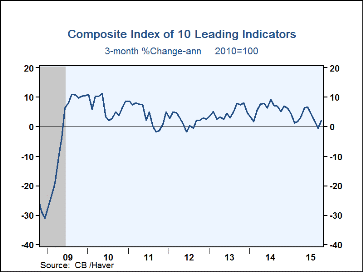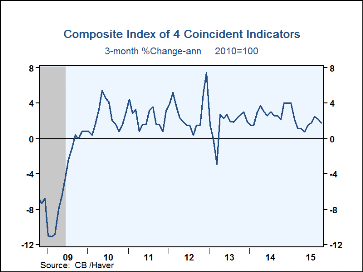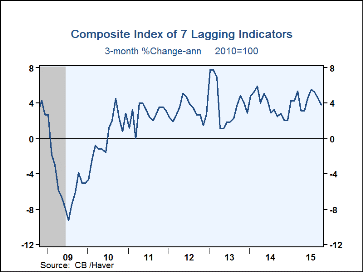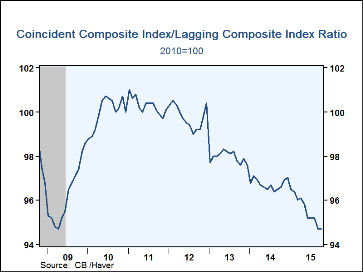 Global| Nov 19 2015
Global| Nov 19 2015U.S. Leading Economic Index Posts Firm Increase
by:Tom Moeller
|in:Economy in Brief
Summary
The Conference Board's Leading Economic Index increased 0.6% during October following two months of slight decline. September's 0.1% dip was revised from -0.2%. The Action Economics Forecast Survey called for a 0.4% October rise. [...]
The Conference Board's Leading Economic Index increased 0.6% during October following two months of slight decline. September's 0.1% dip was revised from -0.2%. The Action Economics Forecast Survey called for a 0.4% October rise. Three-month growth in the index recovered to 2.0% (AR) but it remained down from 6.7% in June. The largest positive contributions to the latest rise came from a steeper interest rate yield curve, higher stock prices, more building permits, an improved leading credit index and fewer initial claims for unemployment insurance. These were offset by a weaker ISM new orders index.
The coincident economic index improved 0.2% after a 0.1% uptick, revised from 0.2%. The three-month growth rate eased to 1.8%, down from 2.5% in August. Nonfarm payroll employment, personal income less transfers and manufacturing & trade sales made positive contributions to the index while industrial production contributed negatively for a second straight month.
The lagging indicators series gained 0.2% after a 0.6% increase, revised from 0.5%. Three-month growth in the index eased to 3.8%, down from the 5.6% high three months ago. More C&I loans, a higher consumer installment credit/personal income ratio and a stronger services CPI made the largest positive contributions to the index. The average duration of unemployment contributed negatively to the total's rise.
The ratio of coincident-to-lagging indicators is a measure of how the economy is performing versus its excesses. As the coincident and lagging series rose by the same amount in October, the ratio held steady at its six-year low.
The Conference Board figures are available in Haver's BCI database; the components are available there, and most are also in USECON. The forecast figures for the Consensus are in the AS1REPNA database. Visit the Conference Board's site for coverage of leading indicator series from around the world.
| Business Cycle Indicators (%) | Oct | Sep | Aug | Oct Y/Y | 2014 | 2013 | 2012 |
|---|---|---|---|---|---|---|---|
| Leading | 0.6 | -0.1 | -0.1 | 3.5 | 5.8 | 3.3 | 2.1 |
| Coincident | 0.2 | 0.1 | 0.2 | 2.2 | 2.5 | 1.9 | 2.6 |
| Lagging | 0.2 | 0.6 | 0.2 | 4.2 | 3.8 | 3.8 | 3.1 |
Tom Moeller
AuthorMore in Author Profile »Prior to joining Haver Analytics in 2000, Mr. Moeller worked as the Economist at Chancellor Capital Management from 1985 to 1999. There, he developed comprehensive economic forecasts and interpreted economic data for equity and fixed income portfolio managers. Also at Chancellor, Mr. Moeller worked as an equity analyst and was responsible for researching and rating companies in the economically sensitive automobile and housing industries for investment in Chancellor’s equity portfolio. Prior to joining Chancellor, Mr. Moeller was an Economist at Citibank from 1979 to 1984. He also analyzed pricing behavior in the metals industry for the Council on Wage and Price Stability in Washington, D.C. In 1999, Mr. Moeller received the award for most accurate forecast from the Forecasters' Club of New York. From 1990 to 1992 he was President of the New York Association for Business Economists. Mr. Moeller earned an M.B.A. in Finance from Fordham University, where he graduated in 1987. He holds a Bachelor of Arts in Economics from George Washington University.










